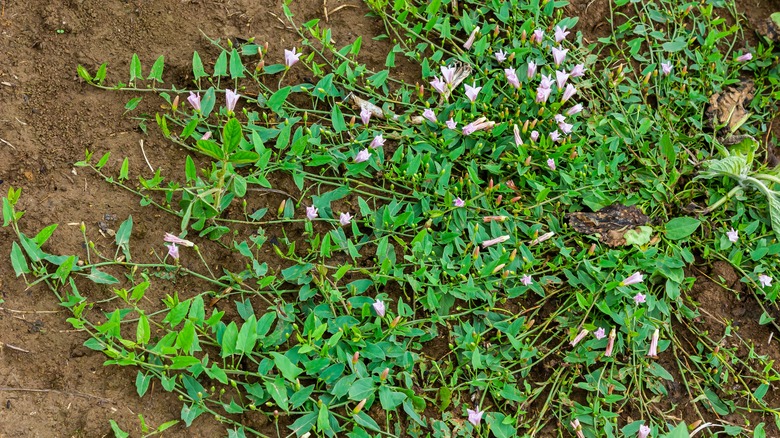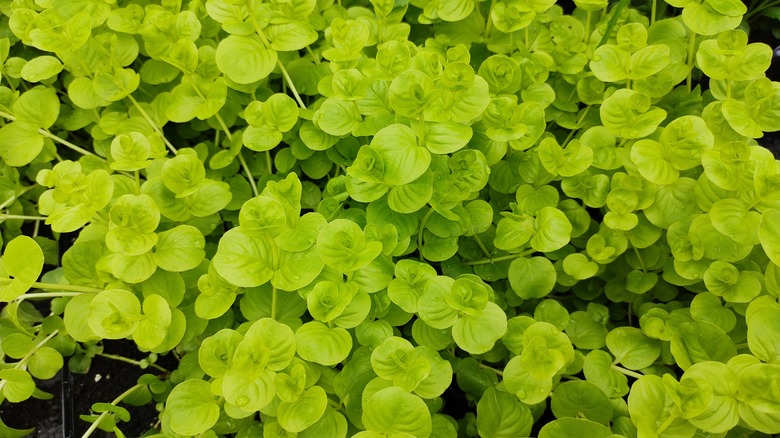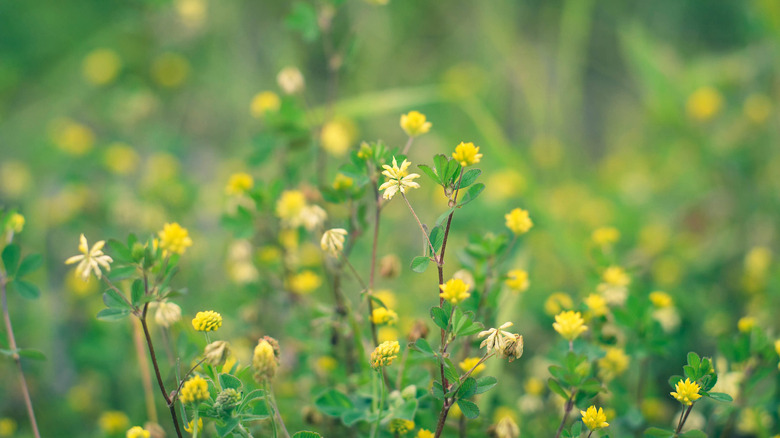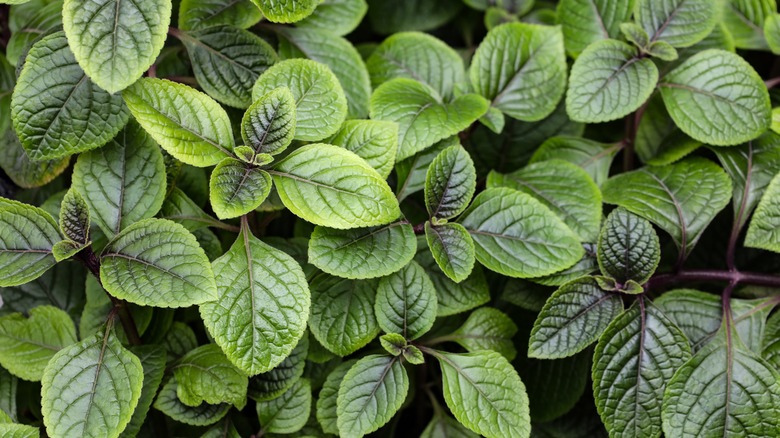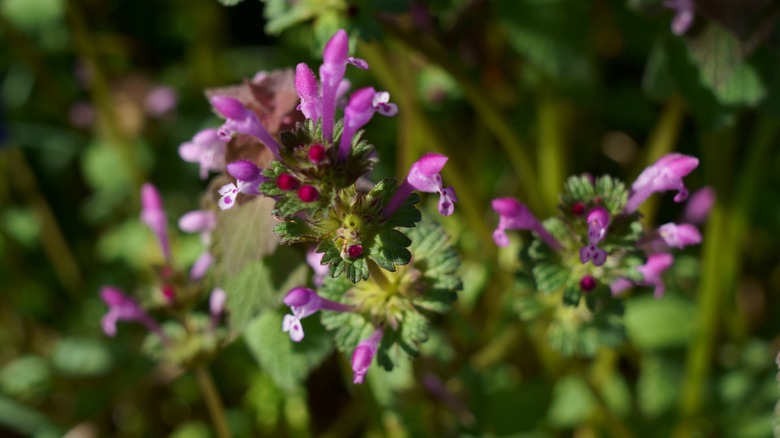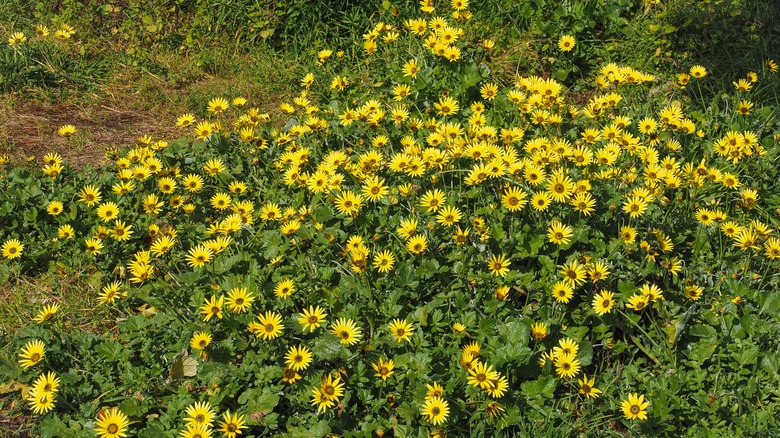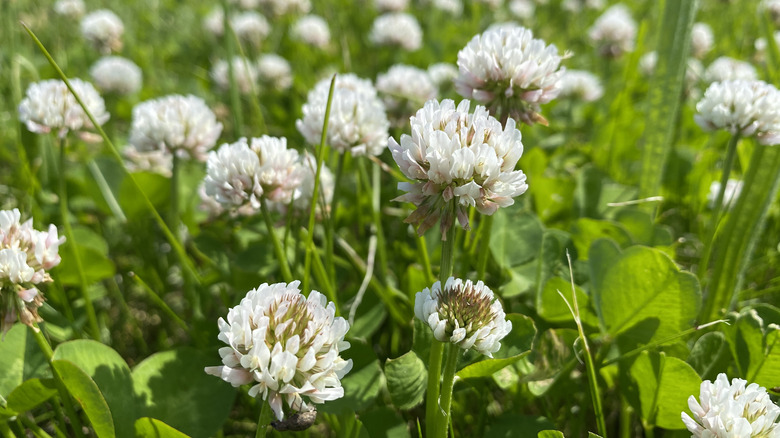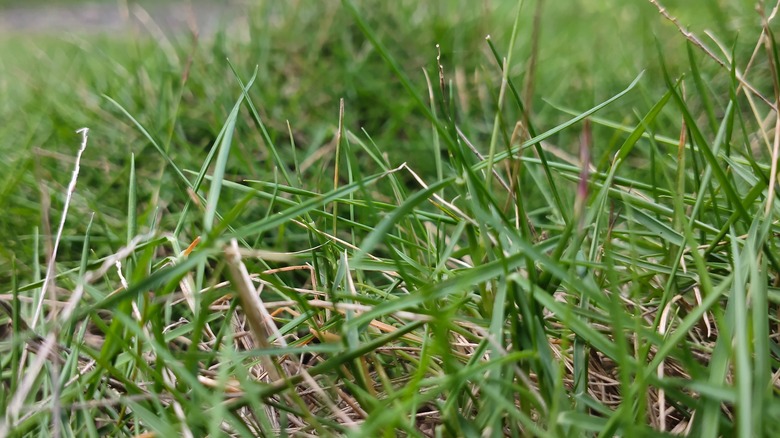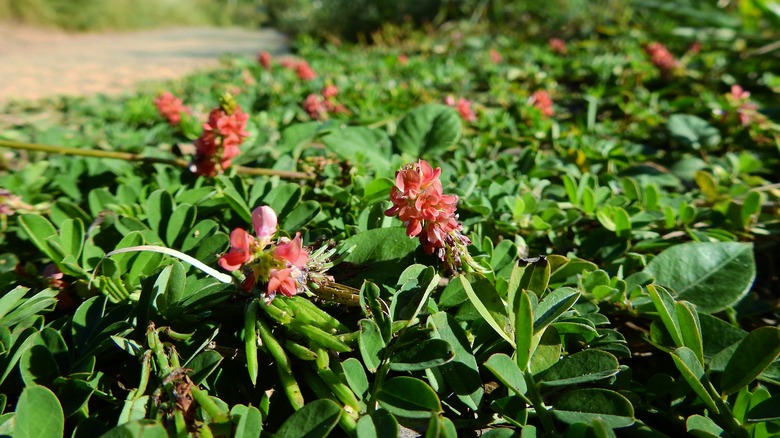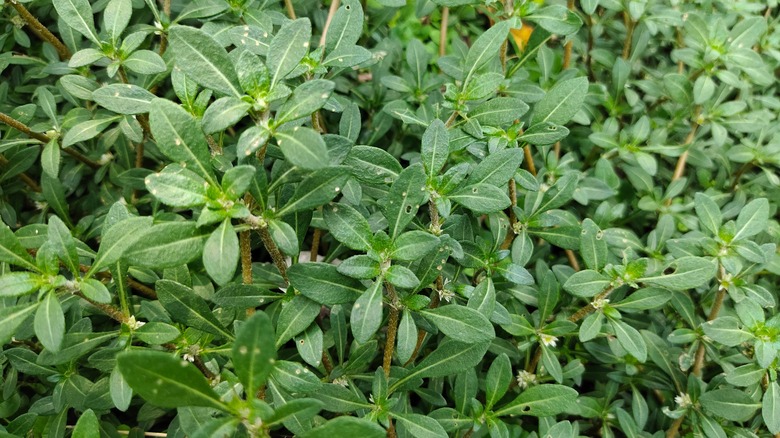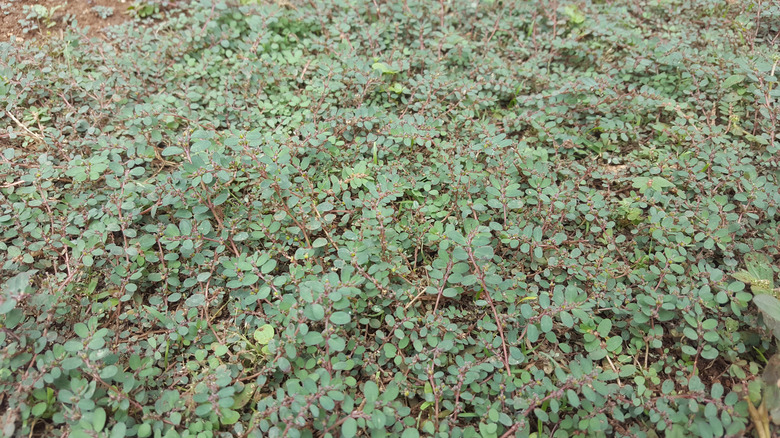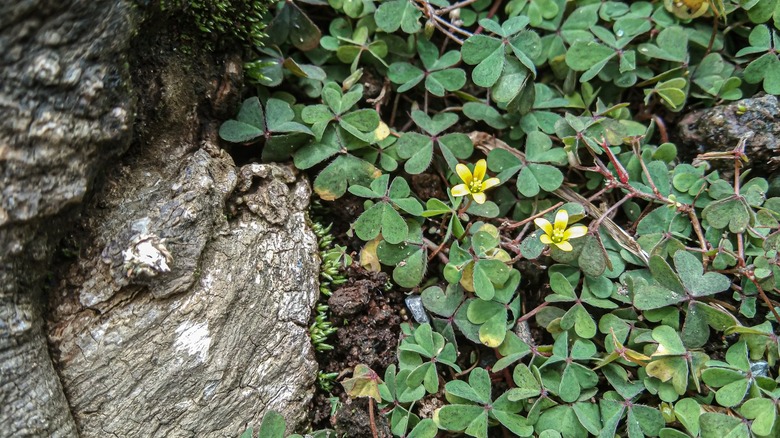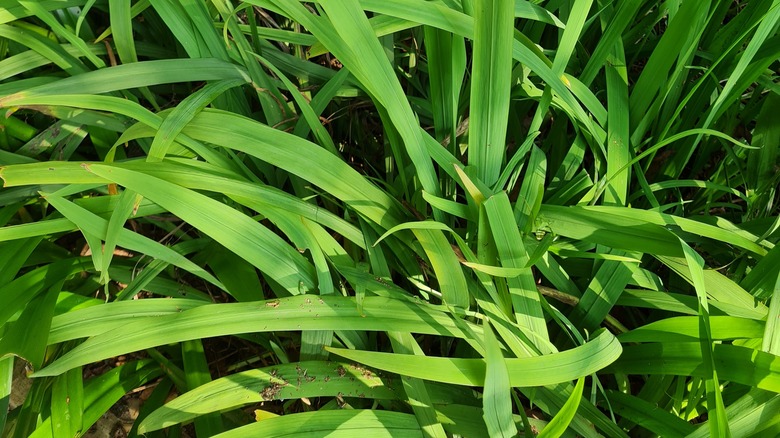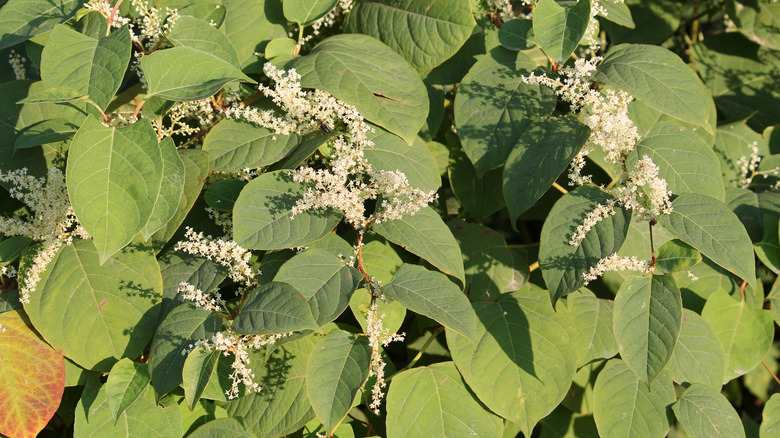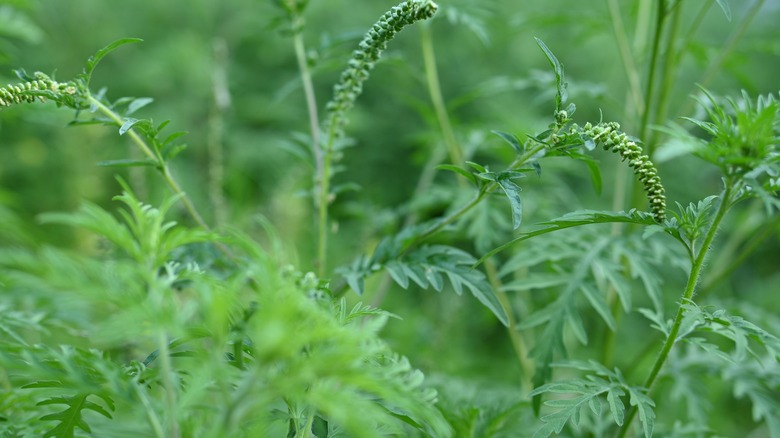15 Creeping Lawn Weeds & The Best Ways To Keep Them Under Control
Keeping your lawn looking its best can feel like a full time job. Spring and summer can be especially challenging as the weather starts getting warmer, and not only is your grass growing quickly — requiring you to pull out the lawn mower more frequently — but weeds are also becoming a more serious issue. In seemingly no time, these weeds can turn your lawn from one that is lush, green, and manicured, to one that looks overrun.
This is especially true for creeping weeds, which are essentially just weeds that grow by "creeping" across a lawn or surface. While it may seem like there is no way to control creeping Jenny, quack grass, capeweed, chickweed, and other creeping lawn weeds, that is fortunately not the case. However, you do need to stay on top of these weeds and know the best ways to get rid of them and keep them from coming back to invade your property. Read on as we'll highlight some of the top ways that you can do just that.
Creeping Jenny
At first glance, bindweed, commonly referred to as creeping Jenny, may look like a purposeful addition to a lawn or garden. However, once you see how it can quickly take over your lawn, you'll be desperate to get rid of this creeping weed. There are two different varieties of this perennial vine, field bindweed and hedge bindweed, both of which are in the same family as morning glories. The vines will spread over the lawn in search of something to climb up, including fences or even other plants. If creeping Jenny does find something it can climb, it does so by twisting around it, making removal complex.
Acting quickly can make it easier to get rid of this invasive weed and can save your yard from being taken over. One of the best ways to get rid of creeping Jenny is to pull it out by hand. Pulling out the roots is ideal, but if you miss a few, just keep pulling it up the next time it comes back. Over time, as you remove the leaves of the plant, the roots will become more and more deprived of food from photosynthesis and the weed will eventually die. Alternatively, you can also smother creeping Jenny by covering the weed with some landscaping fabric and then placing a layer of mulch over the fabric. Doing this will not only block sunlight from reaching the weed, but it will also stop any seeds that have been dropped from germinating.
Black medic
Black medic is another creeping weed that you'll want to banish from your yard. The weed will eventually die off on its own when the temperatures turn colder, but who wants to deal with it all summer long? The weed, which you may also hear called yellow clover, medicago lupulina, or yellow trefoil, has yellow flowers with teardrop-shaped leaves. Shortly before the seeds drop, the pods turn black, explaining the unique name for this weed.
If black medic appears to be taking over your lawn, it likely means that you are mowing the grass too short. Patches of it near sidewalks or roads can also be indicative that the soil has been compacted too much, diminishing the quality of the soil. In addition to letting your grass grow a bit longer between mows, you can also pick black medic by hand — ideally shortly after a rainstorm, when the roots will be removed more easily due to the soil being wet. If you've been spotting black medic along areas where the soil may be too compacted, aerating the soil may also help.
Creeping Charlie
Creeping Charlie is an invasive weed that spreads quickly and densely covers the yard. Not only can it take away the beautifully manicured look of your lawn, but it also takes essential nutrients from the soil, depriving your grass and other plants from benefiting from them. Creeping Charlie has small, scalloped leaves with blue or purplish flowers that appear in the spring and summer. Even if you pull most of Creeping Charlie out from the grass, it will still be able to grow back if a small section is left behind, thanks to its shallow root system.
If you want to banish Creeping Charlie from your yard, be sure to get the soil wet before trying to pull it. Then carefully loosen each stem before pulling it out. Be sure to dig deep enough to remove all the roots. You can also try covering Creeping Charlie with a tarp to block the sunlight and smother the weed — just be aware that this method will also kill the grass too. For large patches, consider a broadleaf herbicide to avoid killing all of your grass while trying to smother the weed. Alternatively, you can also try applying vinegar to creeping Charlie if you want to stay away from herbicides.
Henbit
While henbit is a winter annual, it stays dormant until spring. With heart-shaped leaves and purple flowers, it may seem harmless at first. But, once you learn that each plant can produce as many as 2,000 seeds, it is easy to see how quickly it can spread throughout your yard.
If you want to get rid of henbit, there are a few different solutions you can try. Applying a pre-emergent herbicide in the fall can stop the dropped seeds from germinating and invading your yard the following year. Another option is to pull henbit by hand. However, unless you catch it early before the weed has grown too much, the fibrous root system can make removal difficult. Taking care of your lawn and working to keep the grass thick and healthy can also lessen the chances that henbit will invade (it typically does best in thin and shade-covered areas).
Capeweed
Another creeping weed that can take over your yard is capeweed. Capeweed germinates in the fall, produces seedlings between February and April, and flowers towards the end of the spring or early summer. If you're familiar with crowsfoot, storkbill, or bittercress, it is easy to confuse capeweed with these other nuisances. They all have a similar rosette leaf formation, with the leaves forming a swirling design low to the ground. However, upon closer investigation, you can identify capeweed leaves by their whitish undersides.
If capeweed is starting to make an appearance or fully taking over your lawn, try to act quickly to remove the weeds before they seed and make the task exponentially more difficult. If you're going to use a chemical herbicide, it will be most effective during the fall, between September and November. You can also help prevent capeweed from spreading throughout your yard by keeping your lawn healthy and reseeding any patches of bare soil.
White clover
While a four leaf clover may deliver good luck, you shouldn't consider yourself lucky if you spot white clover growing in your yard. This low-growing perennial weed has tear-shaped leaves that grow in sets of three. As you may be able to guess based on the name, when the weed flowers, its blooms are white. Each flower appears to be made of several smaller white spikes that together form a nearly spherical shape. Unfortunately, the creeping weed can spread over a lawn with relative ease; if a stem node comes into contact with the soil, it can put down roots.
When white clover has started taking over your lawn, consider hand-picking it or using a targeted herbicide to get rid of it. Once you've gotten rid of the weed, you'll want to take measures to prevent it from coming right back. Focusing on the health of your lawn is one way to do this. Perform a soil test to check the nitrogen levels of your soil. If they are low, consider adding some fertilizer; white clover thrives in soil that is low in nitrogen.
Creeping bentgrass
While it isn't technically classified as a weed, if creeping bentgrass invades your lawn without your consent, it may as well be one. The cool-season grass is often selected for golf courses because it handles low-mowing better than other grass types. However, if it spreads to your lawn, it can quickly spread and will even crowd out the existing grass. It generally grows in large patches and has very fine blades. If the lawn is left longer after mowing, the top of the grass will bend down. The grassy weed may not look so bad during the spring when it is green and actively growing, but that will change in the summer. It quickly turns brown, leaving you with dead-looking patches on your once green lawn.
Because of how quickly it spreads across a lawn, it can be very difficult to remove it without killing the rest of your grass. Pulling it out by hand can work, but it will be practically impossible to get every last piece. If you miss any, it will simply grow again. To effectively remove it all from your yard, it may be time to consider pulling up all the grass and reseeding your lawn.
Creeping indigo
While many weeds only flower in the spring and summer, creeping indigo produces flowers year round. The flowers are pink, some with touches of orange, which makes them really stand out against your green grass. Unfortunately, its year-round flowering is not the only thing that makes creeping indigo different, as compared to other weeds. It also has a large tap root, which can make removing it from the lawn complicated. The weed grows out from the tap root, spreading in each direction, but remains mainly flat against the ground.
To rid your lawn of creeping indigo, it is important not to try to kill it too quickly. With many herbicides, the weed will just shut itself down before it is able to absorb the poisonous killer, enabling it to remain mostly unharmed. Instead, opt to pull weeds by hand when possible. Be sure to take extra care to dig the entire root system out. When mowing your yard, use a catcher if creeping indigo is present — this will help prevent further spread of the seeds and infestation of the lawn.
Purslane
Purslane can be an incredibly frustrating weed to deal with. It has leaves shaped like teardrops, yellow flowers, and red or purple stems. The weed remains low to the ground, but can spread out across a yard with ease. In fact, it is one of the most challenging weeds to get rid of. Not only does each plant generate as many as 50,000 seeds, but if even the tiniest piece of leaf or stem is left behind on the lawn, the weed can quickly start growing back. As you can imagine, it doesn't take long for a small patch of purslane to engulf your entire yard. And, wherever it goes, it takes important nutrients and moisture from the grass, threatening its health.
When possible, clear purslane weeds from your yard as soon as possible. With its high number of seeds, you want to limit how many new weeds will grow. When pulling the plant by hand, grab the center of each rosette before pulling it straight up, and always check to make sure that you didn't leave behind any parts of the weed that can regrow. Because of how easy the weed can grow from even the tiniest piece, you'll also want to bag everything you pull up before throwing it away. If preferred, you can also use a broadleaf herbicide to deal with larger infestations.
Creeping spurge
While creeping spurge generally prefers growing around concrete or rocks — such as between the cracks in a sidewalk — it is also possible for this weed to take over your lawn. The invasive weed has a deep tap root, which can make full and effective removal more difficult. Creeping spurge seeds germinate once soil temperatures stay consistently around 75 degrees Fahrenheit and sprout towards the end of spring or the beginning of summer. The seeds will continue germinating until temperatures drop enough for a frost, killing the plant until it reappears the following year.
This is another incredibly difficult weed to remove. Seeds that stay in the soil are still considered viable for about eight years. Moreover, the root systems spread up to 15 feet from the taproot. If you want to remove spurge from your yard, be sure to dig deep enough to get rid of the entire taproot and take care not to leave any pieces behind, as a new weed will likely grow. You can also consider applying vinegar or boiling water over the weed to kill it.
Creeping oxalis
Wood sorrel, or oxalis, looks very similar to clover. However, each of the three leaves on the stalks are shaped like a heart. When the weed blooms in the spring and summer, it produces yellow flowers, each with five petals. Unlike some other weeds, oxalis may grow taller, potentially reaching heights up to 1 foot. The creeping variety of this weed has hair-covered leaves and stems that root themselves as they travel across the yard.
As with other weeds, fast action is recommended to remove creeping oxalis from your yard. If digging the plant up, aim to do so before any seed capsules are present. Alternatively, you can also try a commercially-available weed killer compatible with your grass type to get rid of creeping oxalis. Maintaining a healthy lawn can help prevent creeping oxalis from taking over your yard. Follow mowing recommendations for the type of grass you have to keep it from getting too short and keep up with providing nutrients through feeding and fertilizing the grass.
Quackgrass
It might have a funny name, but quackgrass is no laughing matter. Quackgrass is another creeping weed that has a strong and difficult-to-remove root system. This weed, which can also be called quick grass, dog grass, twitch, or couch grass, can be easy to spot. It grows quickly and will often look taller than the rest of the grass on your lawn. It spreads across a yard through the use of rhizomes that negatively impact the growth of plants in its path. Over time, this can result in the quackgrass effectively killing the grass or other plants in your yard and establishing itself in their place.
If you're faced with a quackgrass problem, you won't be able to simply spray your yard with a selective herbicide. The chemical makeup of quackgrass is too similar to other grasses that you'll end up killing everything you spray. Instead, you can try a non-selective herbicide with glyphosate in its formula. Depending on how much quackgrass you're dealing with and how concentrated its growth is, the best solution may be to remove it and the rest of the grass from the area and start over with some fresh seed. Once you've dealt with the quackgrass problem, aim for a thick and healthy lawn to minimize the chances that the weed will return.
Knotweed
Japanese knotweed is a highly invasive plant that you won't want to see anywhere near your yard. The stems resemble bamboo and may grow to be as tall as 10 feet. The stems aren't the only thing that can grow to be so large. The roots can sprawl up to 65 feet and may reach depths up to 6 feet. With these facts, it's no wonder the plant is also called Godzilla weed. While the weed will die off in the winter, if you don't properly remove it, it will just come back the following spring. Knotweed has green leaves and produces greenish-white flowers towards the end of the summer.
Getting rid of knotweed is possible, but will likely be a difficult and time-consuming task. There are a few different removal options. One option is to try smothering the weed in the spring using tarps and mulch. Cover all sections of the plant with the tarps, being sure to weigh them down with something heavy to keep them in place. Lay out mulch over the tarps and leave the weed covered for several years. Monitor the area and address any new weeds that appear.
You can also try to dig up the roots of the plant. Look for the areas where the most shoots are coming out of the ground, and start digging here to find the rhizomes where these shoots are originating from. Dig up the rhizomes, being careful to remove all sections of it to prevent new weeds from growing.
Ragweed
Even if you can't identify ragweed, you've probably heard it referenced when talking about spring allergies. The pollen from the weed is lightweight and can travel long distances, irritating allergies sufferers in its path. Some varieties of the plant, including perennial ragweed, are considered creeping weeds. Their rhizomes creep beneath the soil, spreading the plant across a yard. Ragweed can grow up to 30 inches and produces cream-colored flowers from July to October. After flowering, the seeds drop. They begin germinating in the fall.
Like many of the creeping weeds on this list, getting rid of ragweed is no easy feat. Because of overuse of herbicides, some ragweed plants are developing immunity, making spraying less effective. If you only have a few ragweed plants, try pulling them up, taking care to remove all of the rhizome and root system. If the weed has already spread across your entire lawn, pulling it up by hand likely won't be feasible. Try mowing the lawn regularly to cut off the stems and leaves. While this won't kill the plant with just one shot, it will weaken the plants and eventually kill them.
